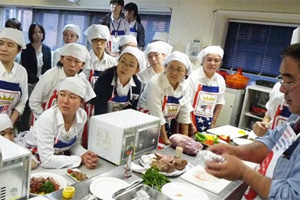USMEF targets Japan to increase pork sales

Japan already is the top value market for US pork, but the US Meat Export Federation (USMEF) is targeting growth opportunities for branded and thick-cut products in two new initiatives designed to increase sales of American pork.
Thick-cut pork chops and roasts are a staple of the American dinner table, but thinly sliced meats are more the standard for chefs and homemakers in Japan. To introduce consumers to new pork cooking techniques that work for larger cuts, USMEF-Japan hired popular cooking instructor Rika Yukimasa to develop US pork recipes – including some for microwave cooking – that will be introduced during a two-month promotion that runs through the end of 2012.
“While pork is a popular choice for Japanese meals, thick-cut pork is not familiar to Japanese consumers or retailers,” said Takemichi Yamashoji, senior marketing director for USMEF-Japan.
USMEF introduced thick-cut US pork at the spring FoodEx food show in Tokyo, and followed that with a promotion with Japanese retail giant Aeon at 2,000 stores across the country. Influenced by Aeon’s success, other nationwide and leading regional supermarkets have begun promoting U.S. thick-cut pork as well.
For the current promotion, Yukimasa demonstrated “easy cooking roast pork” recipes for a group of 160 food bloggers and homemakers to help develop word-of-mouth awareness. The recipes will be featured in the Nov. 7 issue of ESSE magazine (500,000 circulation) in addition to retail point-of-purchase recipes and labeling.
To support consumer awareness at the retail level, USMEF trained demonstrators to cook thicker cuts of US pork in the oven and in the microwave and explain how to interested shoppers. Funding for the thick-cut pork initiatives is provided through the USDA Market Access Program (MAP) and the Pork Checkoff. “Promoting thick cuts has advantages for both retailers and consumers,” said Yamashoji. “Retailers are able to increase sales and quantity, and consumers are able to purchase pork more affordably, particularly compared to domestic pork.”
Branded pork
Competition in Japan’s branded pork market is intense with more than 400 domestic brands competing for consumer attention, but US pork is gaining a foothold in this high-end niche. Earlier this year, USMEF conducted an American Branded Pork Campaign to encourage consumers to purchase branded US pork in supermarkets and restaurants.
To help the Japanese media understand both the explosion of branded pork products as well as the growth of US. branded pork, USMEF brought together representatives from eight national Japanese newspaper outlets for a seminar that included presentations by leading Japanese meat processor Hannan Foods Group as well as the ANA Intercontinental Hotel Tokyo, a regular user of branded US pork. The session was conducted with funding from MAP.
“So far this year, we have focused on promoting US branded pork to traders and distributors, but now we are adding activities to increase awareness of the quality and value of these products to consumers – and to the media outlets that communicate to them,” said Yamashoji.
USMEF-Japan opened the media session by releasing the results of a consumer survey that showed that more than 80 percent of Japanese consumers eat pork more than once each week, and that about 90 percent are familiar with branded pork products in Japan. The survey also showed that only about 30 percent of consumers purchase branded pork regularly, with a third of that group only buying the product for special occasions due to the higher price it commands.
The second presentation was offered by Kyoko Miura of Hannan, who told the story of Mugisodachi Yongen Pork, a wheat and barley-fed pork developed in cooperation with Iowa State University and Independent Meat Company of Idaho.
“Mugisodachi Yongen Pork is a well-marbled product with high-quality fat, which Japanese consumers look for in their pork,” said Yamashoji. “It is very tasty and reasonably priced.”
In the first eight months of 2012, Japan purchased 307,442 metric tons (677.8 million pounds) of U.S. pork valued at more than $1.3 billion, an increase of 6 percent in value on 6 percent lower volumes compared to 2011.
For more info: USMEF







